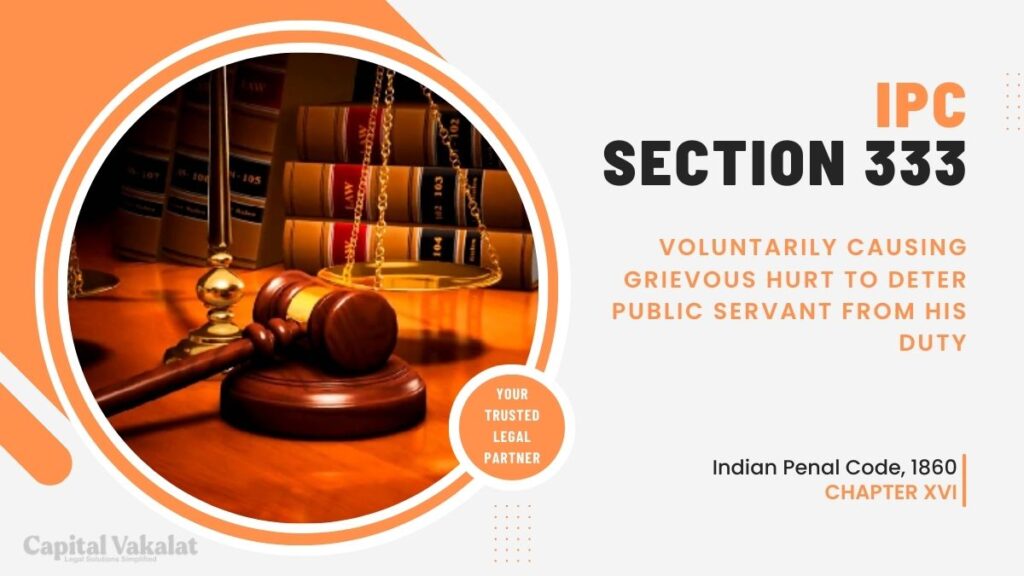In the intricate web of legal provisions defining offenses, Section 333 of the Indian Penal Code (IPC) stands out as a crucial element that addresses the deliberate infliction of grievous hurt to deter a public servant from performing their duty.

This article aims to unravel the complexities surrounding Section 333, delving into its legal nuances, penalties, landmark cases, and its relevance in contemporary society.
Introduction
To comprehend the significance of Section 333, one must first grasp its fundamental premise. This provision, nestled within the IPC, deals specifically with offenses where an individual, with intent, causes grievous hurt to obstruct or deter a public servant from executing their lawful duties. The essence lies in protecting those entrusted with maintaining public order and ensuring the smooth functioning of government machinery.
Understanding Voluntarily Causing Grievous Hurt
In the legal realm, the term ‘grievous hurt’ carries weighty implications. It goes beyond mere bodily harm, encompassing injuries that are severe and potentially life-altering. Section 333 hinges on the voluntary infliction of such harm, emphasizing the deliberate nature of the act. Courts scrutinize the intent behind the actions, distinguishing them from accidental or unintentional harm.
Deterrence of Public Servant from Duty
The provision gains its pertinence in situations where the act of causing grievous hurt is a means to an end – deterring a public servant from discharging their duty. Public servants, be they police officers, government officials, or healthcare workers, play a pivotal role in maintaining order and delivering essential services. Section 333 aims to shield them from threats and physical harm, recognizing the societal ramifications of such impediments.
Legal Elements of Section 333 IPC
For an offense to fall under Section 333, certain legal elements must be satisfied. The accused must have caused grievous hurt intentionally, and the act should be directly linked to obstructing a public servant in the discharge of their duty. This dual requirement establishes a clear nexus between the harm inflicted and the hindrance of official responsibilities.
Penalties and Punishments
The severity of penalties prescribed under Section 333 underscores the gravity of the offense. Those found guilty can face imprisonment and fines. A comparative analysis with related provisions in the IPC sheds light on the distinct punitive measures for offenses against public servants, emphasizing society’s commitment to protecting those serving the public interest.
Landmark Cases
Examining landmark cases involving Section 333 provides insights into the evolution of legal interpretations. Notable instances where the provision was invoked offer precedent-setting decisions that guide subsequent legal proceedings. These cases serve as beacons, shaping the contours of Section 333 and influencing judicial perspectives.
Challenges in Prosecution
While Section 333 serves a crucial purpose, its effective implementation encounters challenges. Establishing intent and causation in the context of obstructing public servants can be intricate. Legal defenses, including self-defense and absence of intent, are commonly employed. Scrutinizing these challenges illuminates the complexities faced by prosecutors in securing convictions.
Relevance in Contemporary Society
In the ever-changing landscape of societal dynamics, Section 333 continues to be relevant. Its application extends beyond traditional scenarios, adapting to challenges posed by modern circumstances. From acts against law enforcement during public protests to assaults on healthcare workers amid health crises, Section 333 adapts to safeguard those on the frontlines.
Critiques and Controversies
As with any legal provision, Section 333 is not immune to criticism. Some argue that its wording might be too broad, potentially encompassing situations where harm was caused without a clear intention to deter a public servant. Debates on the need for refining the language or introducing safeguards to prevent misuse add layers of complexity to the discourse surrounding Section 333.
Conclusion
In conclusion, Section 333 of the IPC emerges as a stalwart guardian of public servants, deterring potential offenders through stringent penalties. Its evolution, marked by landmark cases and adaptability to contemporary challenges, reflects its resilience in upholding the rule of law. As society evolves, so too must legal provisions, and Section 333 stands as a testament to the ongoing dialogue between justice and societal needs.
Frequently Asked Questions
What constitutes ‘grievous hurt’ under Section 333?
Grievous hurt includes severe injuries that go beyond mere bodily harm, often resulting in lasting consequences for the victim.
Can unintentional harm lead to charges under Section 333?
No, the provision specifically requires intentional infliction of grievous hurt with the intent to deter a public servant from performing their duty.
Are there any defenses commonly used in cases under Section 333?
Yes, legal defenses such as self-defense and the absence of intent are commonly employed by the accused in Section 333 cases.
How has Section 333 adapted to contemporary challenges?
Section 333 has evolved to address modern challenges, including offenses against public servants during public protests and assaults on healthcare workers during health crises.